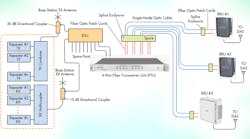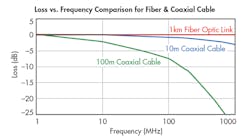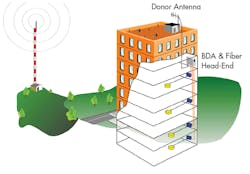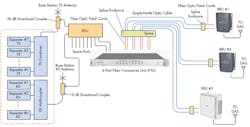Why More RF Engineers Are Choosing Fiber Connectors
This file type includes high resolution graphics and schematics when applicable.
RF-over-Fiber technology has been increasing in capability and decreasing in cost over the past decade. Coupling these factors with the rising cost of coaxial-cable material has prompted many designers to choose RF-over-Fiber optic systems for distributed-antenna systems (DASs) and small-cell applications. Compared to traditional RF-transmission-line technologies, fiber optics offer additional benefits including low loss, interference immunity, high reliability, and security. Despite these advantages, their expense and the need for specialized equipment and components outside of a traditional telecommunications toolbox has delayed adoption in some cases.
RF-over-Fiber refers to the use of fiber-optic transmission cabling and RF-to-optical signal-conversion equipment, which is used to transmit RF signals—generally over long distances. With many of the latest RF-to-optical converters, the RF signal is sent directly to the electronics that power a laser diode. That diode is used to transmit the optical signal along a single-mode fiber cable. The optical signal can be intensity-modulated—a process analogous to amplitude modulation with RF signals. For high-dynamic-range and low-noise applications, a distributed-feedback (DFB) semiconductor laser can be used. For lower-performance requirements, a Fabry-Perot (FP) laser is often implemented.
The optical fibers are made using a time-intensive and somewhat expensive process involving high-quality, specialized glass. This glass is formed into fibers with emphasis on an extremely consistent outer diameter and special jacketing, which prevents optical leakage. Specialized connectors and fiber-processing tools are needed to connect two fiber-optic lines together and reduce reflective losses. For the single-mode fiber that serves RF applications, an angle-physical-contact (FC/APC) connection is used due to its typical return loss of 60 dB and low 0.25-dB connector-to-connector loss. A low return loss helps to prevent any damage to the laser emitter at the RF-to-optical (RF/O) conversion unit.
For the optical-to-RF (O/RF) conversion, a high-speed PIN diode typically converts signals at a rate of 0.9 amperes per watt. Fortunately, the PIN diode has a relatively linear response curve, which limits the nonlinearities and distortion introduced into the signal chain by the conversion. Once it is converted into RF energy and amplified, the RF signal can be transmitted over short runs with traditional RF transmission lines to remote radio heads (RRUs) and then distributed antennas.
In using fiber-optic cables for the long-distance transmission of RF signals, the key benefit is that fiber-optic transmission exhibits less than 0.5 dB of signal loss per kilometer of transmission. Coaxial cables tend to suffer loss ranging from tens to hundreds of times worse than fiber optics. This loss depends upon the frequency of the RF signals (Fig. 1).
Although fiber-optic and RF cables have similar bending radius limits, fiber optics suffer additional loss from bends. Thus, they usually operate better under direct-run installations. Such straighter runs do not always pose a major challenge, as fiber-optic cabling is non-metallic and can be located near high-voltage and electrical cabling with less safety and interference concerns than those encountered with coaxial cable.
The non-metallic and optical conversion in the RF-over-Fiber system also eliminates electromagnetic interference (EMI) and RF interference (RFI) from the transmission line (Fig. 2). Resistive elements, such as non-perfect conductors, also produce noise naturally. As a result, fiber-optic systems tend to introduce less noise into the signal chain than coaxial cabling. Nevertheless, any interference encountered by the RF-to-optical or optical-to-RF conversion electronics will translate to noise and interference in the converted signal.
Thanks to the optical nature of fiber cables, signal interception is nearly impossible without direct access to the optical fiber. Another factor to note is that many fiber-optic cables contain multiple single-mode fibers. Because there is little additional cost per cable meter with the inclusion of additional fibers, large, multi-fiber optical cables are often available. These “dark fibers” are easily integrated into future systems, making an optical system easy to upgrade without significant cost.
This file type includes high resolution graphics and schematics when applicable.
Say Goodbye to Maintenance Woes
This file type includes high resolution graphics and schematics when applicable.
While coaxial cables usually suffer from corrosion, moisture ingress, connector loosening, sparking from over-voltage, and dielectric breakdown, such factors are generally not concerns for fiber-optic lines. It is possible for particulates to build up within a fiber-optic connector, which would increase losses at the connector. Additionally, fiber-optic cables can be resilient in high-heat scenarios, which could cause dielectric breakdown for coaxial cables. There are even fire-resistant fiber-optic cables available.
A distinct difference between fiber-optic and coaxial cables is that the conversion electronics “compress” the power envelope of the RF transmission (Fig. 3). As a result, any electrical surges or noise outside of the transmission band of the RF-to-optical transmitter will not be carried through the optical conversion. Yet this bandpass-like function also reduces the maximum frequency of transmission through an optical line—a limitation dictated by the RF-to-optical conversion electronics. Commonly available equipment ranges to 4 GHz. It should be noted that the fiber-optic system does operate as a wideband system, which can transmit a bandwidth to the maximum conversion frequency (including many RF and some microwave bands).
As is the case with an RF system, there is a maximum power of transmission that an optical transmitter, the optical fiber, and the optical receiver can sustain and operate with linearity. The total power is a composite of all of the signal power across the whole bandwidth of the conversion operation. Often, bandpass filters are employed to enable passing of the bands of interest while limiting power in non-useful frequencies. This approach increases the channel-power headroom. The optical transmission system also is similar to an RF system in that it can induce interference if the same frequency of light is present on the fiber. To enable duplex operation, multiple fibers can be used for multiple uplink and downlink lanes. A lot of fiber-optic cables contain many pairs—sometimes more than 50.
Under conditions where limited fibers are available, duplexing can be done on a single fiber using different frequencies of transmission. This approach is called wavelength-division multiplexing (WDM). An optical fiber has a minimum and maximum frequency of operation, much as the different frequencies within a waveguide propagate with different transmission coefficients. Unlike an RF system, however, optical fiber lines are unidirectional and can have multiple frequencies transmitting in the same or different directions along the fiber.
Given its many advantages, the popularity of RF-over-Fiber has begun to rival traditional RF transmission lines. With more buildings incorporating DASs, there is a high demand for a neutral host system that can serve multiple carriers and public-safety bands. Fiber-optic technology is capable of satisfying those demands, although fiber optics have traditionally been cost prohibitive in some applications. But as the demand for multiple services and extremely wide-bandwidth operation have increased, the maintenance and return-on-investment considerations for RF-over-Fiber could certainly exceed those of coaxial cable. An accelerated rate of adoption may also play a role in lowering the cost of optical technology, enhancing the value proposition of RF-over-Fiber.
This file type includes high resolution graphics and schematics when applicable.




